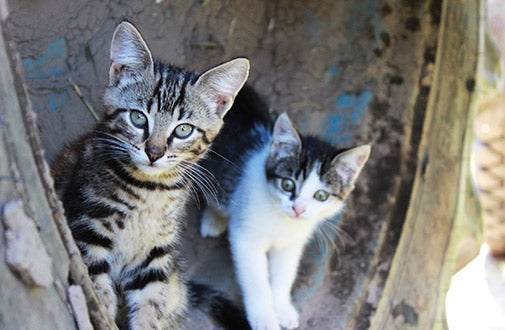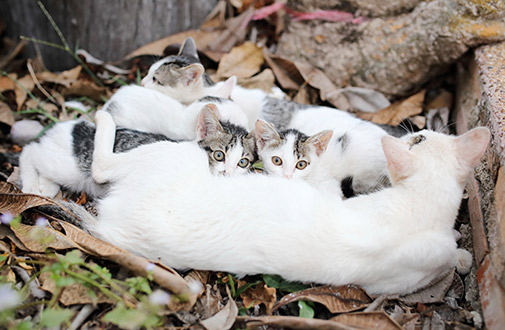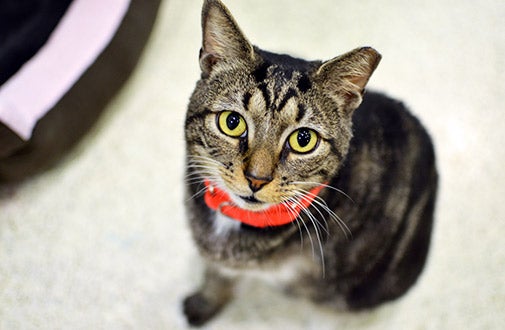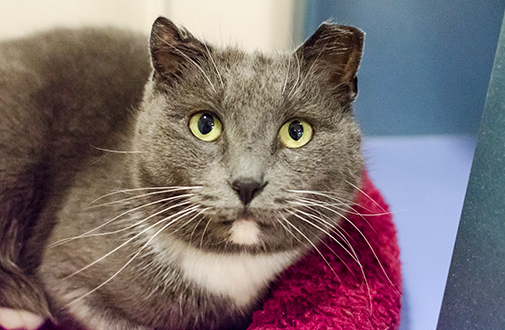 |
| SYD and PIPER (I'm still feeding their mommy on Bay Street) |
I found a brochure in my car this morning, and was going to copy it and paste it here - its a leaflet to distribute to people in neighborhoods where TNR is happening, or colonies are kept. I forgot it in the Jeep, but found this instead. Its excellent, a lot of good tips for those of you, like me, that don't know how to defend the cats when defense is needed.
In the meantime, Milo, the kitty that I rescued from Melville, is a sweetheart, and the person that was going to adopt him changed her mind. Sad. She doesn't know what a great cat she could have had. Butterball remains unadopted, even though she is the sweetest of all. Spread the word. She needs a home with other animals, as she loves to play and cuddle with felines, canines, and humanines. :) Charlie is at the vet now, getting neutered, tested, up to date on shots, and nails trimmed! I just got an update on our newest rescue, Chewy. "We made more progress this morning i can pet her from head to tail and I laid on the floor with Martie and she came out purring and rubbing all over my head and shoulders. She sees Martie likes me and does what Martie does to me."
Chewy's foster is a recent foster 'failure'. If you will recall Martie, the kitty from Melville, all white, that I rescued in the fall. He has turned into a marshmallow, and is Amanda's shadow. Looks like Chewy is looking to Martie to teach her some inside manners. Thanks Amanda, and Martie!
Lets get these cats adopted!!! Spread the word!
A Closer Look at Community Cats
Common Misconceptions and Ways to Help
While the number of community cats in the United States is estimated to be in the tens of millions, sadly, many communities still opt to control populations using outdated, ineffective methods—including lethal elimination or relocation. Community cats who end up in shelters make up a large percentage of cats euthanized throughout the country every year. The ASPCA endorses Trap-Neuter-Return (TNR) as the only proven humane and effective method to manage community cat colonies.

What is a Community Cat?
Community cats include the following:
- Cats born and raised in the wild.
- Cats who have been abandoned or lost and turned to wild ways in order to survive.
While some community cats tolerate a bit of human contact, most are too fearful and wild to be handled. Community cats often live in groups, called colonies, and take refuge wherever they can find food. They will also try to seek out abandoned buildings or deserted cars—or even dig holes in the ground—to keep warm in winter months and cool during the summer heat.
Community Cats Face Many Challenges:
- They must endure weather extremes such as cold and snow, heat and rain.
- Community cats face starvation, infection and attacks by other animals.
- Unfortunately, almost half of the kittens born outdoors die from disease, exposure or parasites before their first year.
- Community cats face eradication by humans. Poison, trapping, gassing and steel leg-hold traps are all ways that humans—including some animal control and government agencies—try to kill off community cat populations.
If a community cat survives kittenhood, his average lifespan is less than two years if living on his own. If a cat is lucky enough to be in a colony that has a caretaker, he may reach 10 years. Community cats who live in a managed colony—a colony with a dedicated caretaker who provides spay/neuter services, regular feedings and proper shelter—can live a quite content life.
Noting the Differences between Stray Cats and Community Cats
A community cat is primarily wild-raised or has adapted to community life. The ASPCA defines a stray cat as someone's pet who has become lost, or who has been abandoned.
- Stray cats are usually tame and comfortable around people.
- They will frequently rub against legs and exhibit behaviors such as purring and meowing. In contrast, community cats are notably quiet and keep their distance.
- Stray cats will also often try to make a home near humans—in car garages, front porches or backyards.
- Most stray cats are completely reliant on humans for food and are not able to cope with life on the streets.
Utilizing Trap-Neuter-Return (TNR) to Manage Community Cat Colonies
TNR is the method of humanely trapping community cats, having them spayed or neutered and vaccinated against rabies, and then returning them to their colony to live out their lives. TNR also involves a colony caretaker who provides food and adequate shelter and monitors the cats' health. TNR has been shown to be the least costly and the most humane, efficient way of stabilizing community cat populations. TNR helps stabilize the population of community colonies and, over time, reduces them. Nuisance behaviors such as spraying, excessive noisemaking and fighting are largely eliminated and no additional kittens are born.
By stabilizing the population, cats will naturally have more space, shelter and food and fewer risks of disease. After being spayed or neutered, cats living in colonies tend to gain weight and live healthier lives. Spayed cats are less likely to develop breast cancer and will not be at risk for ovarian or uterine cancer, while neutered males will not get testicular cancer. Neutering male cats also reduces the risk of injury and infection, since intact males have a natural instinct to fight with other cats. Spaying also means female cats do not go into heat. That means they attract fewer tom cats to the area, which reduces fighting.
How to Help Community Cats and Kittens in Your Area
A community colony caretaker is an individual (or group of individuals) who manages one or more community colonies in a community. The caretaker keeps an eye on the cats—providing food, water and shelter, spaying/neutering and emergency medical care. Some shelters and rescue groups even give out free or low-cost spay/neuter coupons to colony caretakers.
 |  |
If You’d Like to Get Involved:
- Offer your assistance to established colony caretakers. Ongoing needs include feeding, trapping, transportation to and from the veterinarian, temporary housing for cats after surgery, and fostering and socializing kittens for the purpose of finding them good homes.
- Contact local shelters or welfare groups to see if a TNR workshop is available in your area.
- Start with the cats in your own backyard—educate yourself about TNR and learn to trap cats and have them spayed or neutered.
How to Help Community Kittens:
- It is important to trap community kittens and, whenever possible, foster and socialize them until they are old enough to be adopted out. Whenever possible, kittens should continue to nurse until four weeks old—this can be done in captivity.
- Do not let community kittens run loose—they can hide in tiny spaces and are exceptionally difficult to find and catch. Confine the kittens in a dog crate, cat condo or cage with a small litter box, food, water and something snuggly to cuddle in.
- Food is the key to socializing. Give the kittens a small amount of wet food by hand at least twice a day—eventually the kittens will associate your presence with food. For those who are more wild, start by offering baby food or wet food on a spoon through the cage.
- Younger and less wild kittens can be picked up right away. Make a kitty burrito by wrapping a kitten in a towel, allowing her head to stick out. Once the kittens no longer run away from you but instead come toward you seeking to be fed, held and petted, you can confine them to a small room.
- Be sure to expose the kitten to a variety of people.
Basic Tips to Help with TNR Rescue
To get started, take our training, download our TNR guide, or visit the Alley Cat Allies online community for ideas and expertise.
A Few Additional Tips:
- When possible, trap in dry, temperate weather.
- Do not feed the cats for a full 36 hours before trapping, as they must be hungry to enter the trap.
- If you'll be trapping in an area where pet cats are roaming, please inform your neighbors.
- Human-grade tuna, mackerel, sardines and salmon work well as bait. Avoid canned cat food. Place the food inside the trap, behind the trip plate, so the cat is sure to step on it when eating.
- Transport the trapped cat to your veterinarian for spaying or neutering immediately upon capture.
- To reduce anxiety, place a sheet or towel over the trap so the cat feels secure.
- Ask that the cat be ear-tipped—have the tip of one ear snipped during surgery—to help future rescuers identify him. This is a painless and risk-free procedure.
What is Ear-Tipping and Why Is It Important?
Ear-tipping is a widely accepted means of marking a community cat who has been spayed or neutered. It also often identifies them as being part of a colony with a caretaker. Ear-tipping is the humane, safe surgical removal of the top quarter-inch of the left ear. The procedure is performed by a licensed veterinarian, typically during the spay/neuter surgery and rarely requires aftercare. Ear-tipping prevents an already-spayed or neutered cat the stress of re-trapping and an unnecessary surgery.
 |  |
How to Deal with Difficult Neighbors
To help your cats be better neighbors to your neighbors, kindness and patience are key. Find out what about the cats is bothering your neighbors and work with them on those specific issues. Let them know that TNR offers a solution that helps both the cats and the human residents.
Pointers to Consider When Interacting With Difficult Neighbors:
- Establish a friendly relationship with people living near a community cat colony.
- Present information in a reasonable, professional manner and address individual complaints by listening patiently. Always maintain a constructive, problem-solving attitude.
- Explain diplomatically that the cats have lived at the site for a long time and that they have been or will be sterilized, which will cut back on annoying behaviors.
- Explain that if the present colony is removed, the problems will recur with new cats.
Sprays, motion-activated sprinklers and ultrasonic animal repellents, coupled with TNR and ongoing management, can help you and your neighbors coexist with your neighborhood cats. Just make sure your product of choice is nontoxic to animals.
Will Animal Shelters Adopt Out Community Cats?
Community cats are not adoptable and shelters rarely will accept them. The fact is, most community cats exhibit wild, shy or frightened behavior, and it's impossible to predict how or if they will ever acclimate to indoor life. While a community cat might look exactly the same as a pet cat, community cats survive by avoiding close human interaction. When properly cared for, community cats are happier outdoors in their own territory.
Some semi-community cats are actually stray cats who don't exhibit quite the same shy behavior as the majority of community cats. Occasionally, these cats are born in the wild but, for no particular reason are less fearful of humans than is typical. Many semi-community cats lack the knowledge to survive on their own, and are often rejected by established colonies. It is possible for some of these cats to be socialized, but it depends on their trust of humans. It is very important to take caution, especially with cats who seem to straddle the fence between community and friendly. Getting them to trust people again might be hard, making them extremely difficult to adopt out.
Ineffective Methods for Managing Community Cat Populations
Eradication: The deliberate and systematic destruction of a community cat colony, by whatever method, almost always leads to the “vacuum effect”—either new cats flock to the vacated area to exploit whatever food source attracted the original inhabitants, or survivors breed and their descendants are more cautious around threats. Simply put, eradication is only a temporary fix that sacrifices animals' lives unnecessarily, yet yields no positive or beneficial return.
Relocation: Many communities have rounded up colonies of community cats either for euthanasia or to relocate them to another area. This does not work, because community cats are very connected with their territory: They are familiar with its food sources and places that offer shelter, as well as resident wildlife, other cats in the area, and potential threats to their safety. Even when all community cats are removed, which is difficult to achieve, new cats will soon move in and set up camp.
Relocation is something to consider only if keeping the cats where they are becomes a threat to their lives, such as their territory being demolished and there is no adjacent space to shift them to, or if the cats' lives would be at extreme risk should they remain where they are.
Have a nice day!


No comments:
Post a Comment